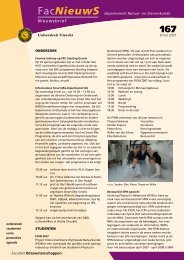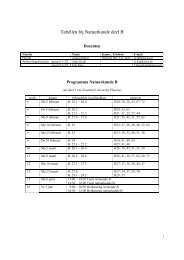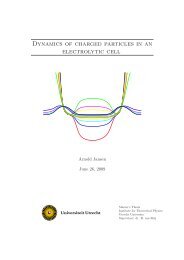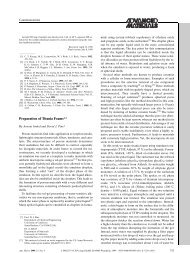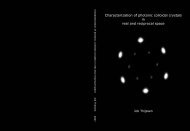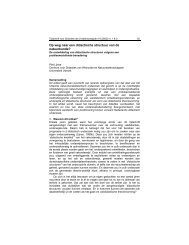Sedimentation Equilibrium of Mixtures of Charged Colloids
Sedimentation Equilibrium of Mixtures of Charged Colloids
Sedimentation Equilibrium of Mixtures of Charged Colloids
You also want an ePaper? Increase the reach of your titles
YUMPU automatically turns print PDFs into web optimized ePapers that Google loves.
species, and (B) L i = 2 × (250/Z i ) 3/2 mm. Case B mimics the situation forspheres <strong>of</strong> different size but the same mass density and surface charge density,such that Z i is proportional to the surface area and L i to the inverse volume<strong>of</strong> species i, i.e. L 2 i Zi3 is a constant independent if i. The density pr<strong>of</strong>iles,numerically obtained by solving the Eqs.(A.3) and (A.4) for H = 20cm,λ B = 2.3nm, ρ s = 3µM, and ¯η tot = ∑ 21i=1 ¯η i = 0.005, are shown in Fig.3 forall 21 components. Case A shows pr<strong>of</strong>ound lifting and layering, where theordering is again determined by mass-per-charge as illustrated by the threedashed curves (for Z i = 250, 279, and 299) showing that the colloids in thehigh-charge wing <strong>of</strong> the distribution reside at high altitudes. Fig.3(b) showsthe density pr<strong>of</strong>iles for case B, which does exhibit lifting, but hardly anylayering, and no density inversion at all. This is completely consistent withthe picture that the ordering is determined by Z i L i , which for case B is suchthat Z i L i /Z j L j = √ Z j /Z i , i.e. the highly-charged particle are expected atthe bottom while the relative spread in Z i L i is relatively small compared tocase A, where Z i L i /Z j L j = Z i /Z j . The inset <strong>of</strong> (b) shows the total packingfraction pr<strong>of</strong>iles η tot (x) = ∑ 21i=1 η i(x) <strong>of</strong> both case A and B together with theone-component pr<strong>of</strong>ile (n = 1) with Z 1 = 250 and L 1 = 2mm at ¯η 1 = 0.005.Perhaps surprisingly there is hardly any distinction between the pure systemand case B, whereas there is a small difference with case A. These pr<strong>of</strong>ilesshow that the main distinction between these polydisperse systems and theunderlying one-component one concerns the layering phenomenon (providedZ i L i varies sufficiently for all the species), and not the total distribution <strong>of</strong> thecolloids. Perhaps this fractionation effect could be exploited experimentallyto purify a polydisperse mixture.A.6 Conclusions and discussionWe have studied sedimentation equilibrium <strong>of</strong> n-component systems <strong>of</strong> chargedcolloidal particles at low salinity by minimising a Poisson-Boltzmann-likedensity functional w.r.t. density pr<strong>of</strong>iles on a one dimensional grid <strong>of</strong> heights.For n = 1 the theory reduces to the one-component studies as presented inRef.[8, 14], and for n = 2 we quantitatively reproduce the simulation results<strong>of</strong> Ref.[15], where density inversion was found. These effects are caused by aself-consistent electric field that lifts the higher charged (heavy) particles tohigher altitudes than the lower charged (lighter) colloids. We show that thelayering <strong>of</strong> the colloids according to mass-per-charge can persist for ternary(n = 3) as well as for polydisperse (here n = 21) mixtures. Given the goodaccount that the present theory gives for simulations [14] and experiments[11, 12, 13] <strong>of</strong> one-component systems, and for the simulations <strong>of</strong> binary60



